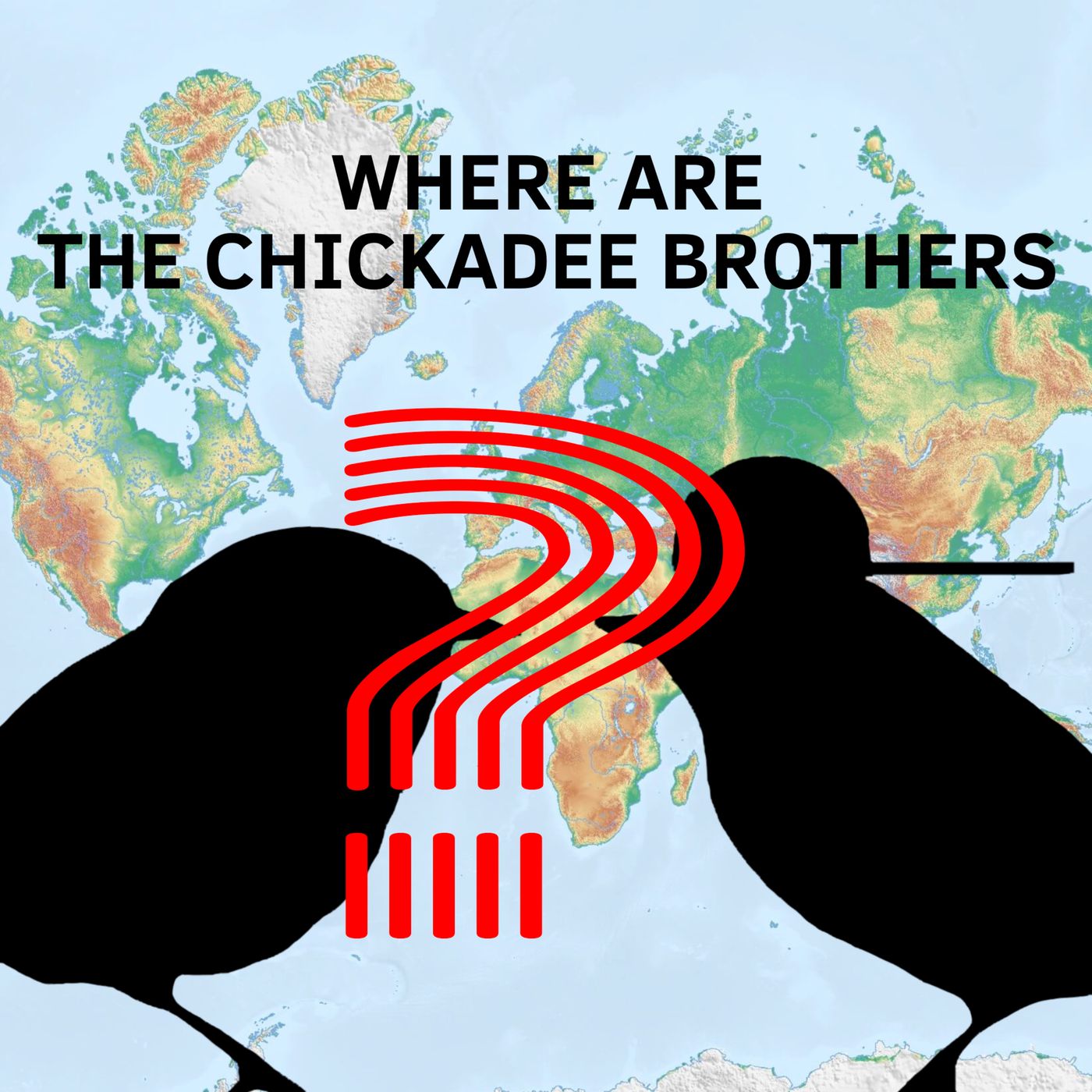
Kingdom: Animalia - A Zoology Podcast for Kids
This is a for-kids-(and adults)-by-kids-(and chickadees) animal podcast. In every regular episode, your host, Devon, and podcast-overthrowal-plotting chickadee co-hosts, Chet and Cap, will dive into all the facts about one species of animal with jokes, fun facts, and quizzes along the way. Every third-ish episode is our game show, Animalia Fake!, in which there are three rounds with four outrageous animal facts; one of those facts is so outrageous it’s an Animalia Fake (it’s not true), and you have to guess which it is.
You can send in questions and episode suggestions to animals@kapods.org, and my website is https://kapods.org/animals. So what are you waiting for? Let’s explore this amazing Kingdom: Animalia.
New episodes every 1–2 months.
Kingdom: Animalia - A Zoology Podcast for Kids
Giant Panda
It’s time for some panda-monium!
______________________
Why are pandas bamboo-etarians? Do they eat anything other than bamboo? How come Giant Pandas are black and white? Which was the original panda, the Red or the Giant? Just how big are Giant Pandas? Today with your host, Devon, and co-hosts, Chet and Cap, on our first listener-suggested episode, you will learn everything there is to know about the Giant Panda, Ailuropoda melanoleuca.
Links:
- Subscribe to the Newsletter
- Listen to our new podcast, Where Are the Chickadee Brothers?
- Episode Page
- Comic
- Memory Quiz
- Transcript
- Works Cited
Credits:
- Additional Music: Blue Dot Sessions
If you have any questions, comments, episode suggestions, or verification that I’m not just talking into the void, please send them in (links below)! It really means a lot. Also, if you like this podcast, please share it with someone else who might!
Get in Touch: animals@kapods.org or kapods.org/contact
Visit My Website: kapods.org/animals
Follow in Your Favorite App: kapods.org/animals/follow
**Psst! Hey, you! It’s Chet and Cap! Do you have any questions for us? Just head over to kapods.org/acb and send a voice message or email with your questions, and we’ll answer them on an Ask the Chickadee Brothers episode of this podcast!**
Until next time, keep exploring this amazing Kingdom: Animalia.
This podcast is made by Kingdom: Animalia Podcasts.
00:00
SOUNDS: [Intro music]
BACKGROUND: [Cricket song slowed down starts]
DEVON: Hello podcast listeners and welcome back to Kingdom: Animalia - A Zoology Podcast for Kids! I’m excited to be back from our brief hiatus and back to teaching you about this amazing Kingdom: Animalia. If you didn’t hear, our break was to work on Kingdom: Animalia Podcasts’ latest show: Where Are the Chickadee Brothers?: A for-kids-by-kids fictional audio adventure starring me--
CHET: …Chicka But mostly Chicka us.
CAP: Chicka Mostly us.
DEVON: On that, I guess, we can agree.
CAP: Chicka I’m glad Chicka you agree, Chicka underling.
DEVON: Mumbling: I’m glad you’re not letting it go to your heads.
CHET: Chicka Your opinion Chicka is not Chicka needed, underling.
DEVON: The website is kingdomanimaliapod.com/watcb.
CAP: Chicka That isn’t Chicka your job, Chicka underling.
DEVON: *Sigh* Alright, let’s move on, shall we?
CHET: Chicka That’s not Chicka your call, Chicka un--
DEVON: Say that again, and you lose your birdseed allowances for today.…I thought so. Okay. So, in case you forgot or are listening for the first time, I’m your host, Devon,…
CHET: Groaning: …Chicka And we’re Chicka your co-hosts, Chicka Chet…
CAP: Groaning: …Chicka And Cap.
DEVON: And today on Kingdom: Animalia - A Zoology Podcast for Kids, we’re learning about our first listener suggested animal: the Giant Panda, Ailuropoda melanoleuca; the world’s only mostly vegetarian bear. Enjoy.
SOUNDS: [Snap]
BACKGROUND: [Crickets fades out]
DEVON: As usual we’re starting with the--
CHET: Chicka Admitting your Chicka in awe Chicka of being Chicka in the Chicka presence of Chicka the amazing Chicka actors, Chet Chicka and Cap Chicka Chickadee!
DEVON: That’s a new one, but no. The description. The Giant Panda, also known as the Panda Bear, or simply the Panda, is, though not always known to be, a bear. They have the same general shape as most bears. To aid in gripping bamboo shoots, Giant Pandas have… A), inflated paw pads on their forepaws that increase the surface area of their paws, B), extra long foreclaws to hook around the bamboo shoot, or C), elongated wrist bones that function as opposable thumbs?
CAP: Chicka D! Chicka Caps to Chicka scoop up Chicka the bamboo Chicka with!
DEVON: Not an option, Cap.
CAP: Chicka Fine. Chicka A.
CHET: Chicka And I’ll Chicka go with Chicka B.
DEVON: The answer is, drumroll please, Chet…
CHET: Chicka Here we Chicka go again. Chicka Fine.
SOUNDS: [Drumroll]
DEVON: …C), Elongated wrist bones that function as opposable thumbs in addition to their regular five digits. You’re both wrong.
SOUNDS: [Incorrect] [Trumpet Whomp]
DEVON: These “bonus thumbs” are only found on their forepaws, but their hind paws are also unique in that they point inwards, towards each other, instead of straight forward; giving them a waddling gait. Continuing with--
CAP: Chicka Caps!
DEVON: No! Shape. Giant Pandas have large molars and strong jaw muscles for chowing down on tough bamboo.
SOUNDS: [Crack]
DEVON: Though many people think Giant Pandas are chunky, lumbering, and cute animals, Giant Pandas can be just as dangerous as other bears, but since they don’t have much of a taste for flesh, they’re a little less likely to attack. The panda is about the size of an American Black Bear, standing two to three feet or point six to point nine meters at the shoulder (on all fours) and are four to six feet or one point two to one point eight meters long, head to their quote on quote “tail”. Females weigh up to two hundred twenty pounds or one hundred kilograms and males up to two hundred fifty pounds or one hundred thirteen kilograms. As many of you might know, Giant Pandas are white overall with black eye patches and black fur on their ears, muzzle, shoulders, and legs. Here’s the big question: Why does the Giant Panda look like a cross between a Polar Bear and a Dalmation? Is it A), to camouflage, B), to signal to other pandas, C), to regulate temperature, D), all of the above, or E), none of the above?
CAP: Chicka E?
CHET: Chicka D?
DEVON: Chet, you know what to do…
CHET: Chicka What?
DEVON: Chet…
CHET: Chicka Oh, oh, Chicka right.
SOUNDS: [Drumroll goes in background]
DEVON: The answer is… a trick question! D and E! That means you’re both… half right.
SOUNDS: [First half of Correct] [Second half of incorrect]
CHET: Chicka Huh?
CAP: Chicka Huh?
DEVON: Scientists aren’t quite sure. The first theory is A, to camouflage. In patches of bamboo, a sitting panda virtually disappears amung snowy rocky outcroppings on mountain slopes. But this wouldn’t make sense, because Giant Pandas have no natural predators to hide from.
CHET: Chicka But what Chicka about the Chicka babies?
DEVON: Good point Chet,…
CHET: Chicka Thank you.
DEVON: …but…
CAP: Chicka Hehe.
CHET: Chicka Rrrr.
DEVON: …but then wouldn’t they grow out of it? The babies of all sorts of animals, from Mountain Lions to White-tailed Deer, have coats of fur for extra camouflage, but once they’re adults, and they don’t need it anymore, their coat changes. Another hypothesis (B) is that the pattern may help accentuate social signals (make them more noticable) or help pandas identify each other from a distance so they can avoid socializing, as they are typically solitary. The third (C) is for temperature regulation, saying that the black absorbs heat and the white reflects it, keeping the temp around the panda stable (this is similar to one of the many theories of why zebras are black and white, but we can talk about that in a future episode). Unfortunately, scientists still don’t have a solid answer for why pandas look the way they do. For now, let’s move on from this bamboozling subject.
SOUNDS: [Rimshot 1]
DEVON: If we were to continue it would become pandamonium!
SOUNDS: [Rimshot 1]
DEVON: And that you probably wouldn’t bear!
SOUNDS: [Crickets sound effect]
DEVON: Uh, Chet? Chet?
CHET: Chicka Can we Chicka just move Chicka it along?
DEVON: At least the crickets like it!
SOUNDS: [Crickets stop]
DEVON: Tough crowd. Okay, fine. The Giant Panda’s thick, wooly, and shrouded-in-mystery coat helps keep the bear warm in the cool bamboo forests of their habitat, especially in the winter. Quiet: You happy now?
DEVON: I haven’t yet mentioned it, but there are two pandas: The Giant Panda (the one we’re talking about) and the Red Panda. But what’s the deal? Are they the same type of animal? Different? Well now I’m going to teach you a crash course on <echo><Giant Pandas> vs <Red Pandas>.
SOUNDS: [[Giant Panda (Right)] [Red Panda (Left)]] [[Red Panda (Right)] [Giant Panda (Left)]]
BACKGROUND: [Crash Course music starts]
CAP: Chicka Difference nu– Chicka Wait, what? Chicka Introduction?
DEVON: Yup. We’re doing an introduction this time for some background info about their connection. Here I’m explaining why they’re both called pandas. The name “panda” is believed to likely come from the Nepali word “ponya”, which means “bamboo eater” or “bamboo footed”. This name was given to the Red Panda, who lives in the Himalayas where Nepali is spoken, not to the Giant Pandas who don’t live there. The Red Panda was first classified and described by science in 1825, but Giant Pandas weren’t described by science until much later, in 1869, gaining their “pandahood” due to the similarities they have with the quote on quote “original”, like eating bamboo. The Giant Panda has just gotten more famous over the years, even earning the privilege of being called simply “panda”. I bet the Red Panda doesn’t like that. Even as I typed “panda” into the script, my keyboard suggested a Giant Panda emoji, no Red.
SOUNDS: [Email received]
DEVON: Oop—I just got an email, live as we’re recording. It says the following:Subject:“Concerns around the panda name”.Body:“To Whom It May Concern:“Thank you for acknowledging my being the ORIGINAL [in all caps] and only TRUE [also in all caps] panda, and the injustice of the bear being the face of the panda name. Though I am still highly offended you are focusing on the bratty name thief, known as the Giant Panda, on your podcast instead of the Red Panda.“Cold regards,“Patricia Johnson“Lawyer, Ponya Incorporated.”Ohh-kayyy. Let’s move onto the differences, shall we?
CAP: Chicka Difference number Chicka one (this Chicka is what Chicka I’m used Chicka to):
DEVON: Classification. Scientists haven’t always known Giant Pandas are bears: they’ve debated whether they’re bears, raccoons, or something original—but now, thanks to genetic evidence, scientists know they are bears. Red Pandas are different: They are the only extant (extant being the opposite of extinct) member of their taxonomic family, AIluridae. They, like the Giant Panda, are of the taxonomic order carnivora, and their closest living relatives are most likely the weasel, skunk, and raccoon families.
CAP: Chicka Difference number Chicka two:
DEVON: Coloration. As mentioned, the Giant Panda has black fur on their ears, around their eyes, muzzle, and on their shoulders and legs, with the rest of their body being white; Red Pandas, on the other hand (or paw), are overall a ruddy orangish color with reddish-brown tears that go from their eyes down to the corners of their mouth. Their tails call to their raccoon relatives with alternating red and darker buff rings.
CAP: Chicka Difference number Chicka three:
DEVON: Shape. The Giant Panda, not surprisingly, has the body of a typical bear, as said. They are heavily-built, lumbering animals with large molar teeth and strong jaw muscles for crushing bamboo. Red Pandas, again, are very different. They have large, round heads with short snouts and big, pointy ears. They have long, bushy, again raccoon-like tails that help these arboreal mammals balance in trees and keep them warm in the harsh Himalayan winters. They have dense fur that covers their entire body, including their paws, a trait very few mammals have. They have semi-retractable claws and a bonus thumb like Giant Pandas.
CAP: Chicka Difference number Chicka four:
DEVON: Size. As mentioned, the Giant Panda is up to three feet or point nine meters at the shoulder, up to six feet or one point eight meters long, and weighs up to two hundred fifty pounds or one hundred thirteen kilograms. Yet again, the Red Panda is different: They are up to three hundred fifty feet or one hundred and nine meters long and tip the scales at seventeen hundred pounds or two hundred seventy-three point five kilograms.
CHET: Chicka Say what??
DEVON: Okay. Just kidding. They are much smaller than Giant Pandas, at up to three point five feet or one point o nine meters long and weigh seventeen pounds or twenty-seven point three kilograms.
CHET: Chicka Okay, that Chicka makes more Chicka sense.
DEVON: Yup.
CAP: Chicka Difference number Chicka five:
DEVON: Range and Habitat. As I’ll get into with more detail soon, Giant Pandas live in old-growth conifer forests (with bamboo, of course) in a pawful of mountain ranges in south central China, while Red Pandas live in the high-altitude, temperate forests with understories of bamboo in the Himalayas and other high mountains. Their range extends from northern Myanmar to western Sichuan in China. They can also be found in Nepal, India, and Tibet.
CAP: Chicka Difference number Chicka six (Chicka There are Chicka a lot Chicka today):
DEVON: Diet. Giant Pandas eat almost nothing but bamboo, up to ninety-nine percent of their diet, only on rare occasions eating anything else. Red Pandas cut it down a bit with ninety-five percent of their diet being bamboo and eggs, lizards, small birds, and small mammals as that other five percent. They’re also much pickier about bamboo, where Giant Pandas eat the entire bamboo (except the roots), Red Pandas only eat the nutritious tips of the leaves and tender shoots when available.
BACKGROUND: [Music ends]
DEVON: This concludes our crash course on <echo><Giant Pandas> vs <Red Pandas>.
SOUNDS: [[Giant Panda (Right)] [Red Panda (Left)]] [[Red Panda (Right)] [Giant Panda (Left)]]
DEVON: Giant Pandas are big sleepers: when in the wild, they typically nap between feedings for—A), One to two, B), two to four, or C), three to six hours at a time? Cap?
CAP: Chicka I’ll go Chicka with B.
DEVON: Chet?
CHET: Chicka B?
DEVON: Give me a drumroll please, Chet…
CHET: Chicka I guess Chicka it’s in Chicka my contract.
SOUNDS: [Drumroll goes in background]
DEVON: The answer is… B! You’re both right!
SOUNDS: [Correct]
CHET: Chicka Oh, yeah!
SOUNDS: [Airhorns]
CAP: With airhorns: Chicka Peeoo peeooo!
BACKGROUND: [Applause] [Hip-Chickadee-Hop starts]
CHET: Chicka We’re the Chicka greatest!
DEVON: It was just one que--
CAP: CHICKA WE’RE ON CHICKA TOP OF CHICKA THE WORLD!!
DEVON: Alright, that’s it.
SOUNDS: [Click]
BACKGROUND: [Applause stops] [Hip-Chickadee-Hop stops]
CHET: With Cap: Grumbling: Chicka C’mon, Devon.
CAP: With Chet: Grumbling: Chicka Fun killer.
DEVON: *Sigh*. They will nap on their side, back, or belly, (just like humans) either sprawled or curled up (also like humans). Napping can increase to up to <reverb><six or more> hours during the summertime. Scientists actually aren’t quite sure how long Giant Pandas live in the wild, all they now is that it’s shorter than in captivity—the current theory is fifteen to twenty years—they usually live up to thirty years in captivity, though some Chinese scientists report pandas living up to five years longer. Pandas, like most bears, can easily stand on their hind legs. They are quite playful and are commonly observed somersaulting, rolling, and dust bathing. Giant Pandas are in fact nocturnal, being mostly active during the nighttime and twilight hours.
DEVON: Giant Pandas don’t communicate to each other with visual signals—They can’t communicate with facial expressions because they don’t have very expressive faces. They can’t communicate with their tails because they’re tiny stubs. Their ears aren’t flexible enough to move significantly. No crest or mane to position. Scientists believe they lack these abilities because--
CAP: Chicka They’re too Chicka busy wearing Chicka caps!
DEVON: No. Because--
CHET: Chicka Birdseed!
DEVON: That makes no sense. No, because of their habitat and solitary nature. Giant Pandas live in dense, foggy bamboo forests that obstruct (block) a direct line of sight—preventing visual signals. Secondly pandas are solitary—socialization only really occurring during mating and cub raising. One way they do communicate is through smell. Each panda has a home range of around one point five to two point three square miles or four to six square kilometers, often overlapping with each other substantially. In these situations, Giant Pandas use scents to avoid coming into contact with each other. They have a large scent gland below their tail and surrounding their butt which they use to leave scent messages for other pandas by rubbing it against rocks, trees, and clumps of grass; these scent messages say who they are, whether they’re male or female, and maybe even social status—kind of like dog pee. Thanks to chemical analysis, we know that females and males often use scent markings differently: females seem to mainly use scent marks to signal if they’re ready to mate and males mainly to identify territory. Another way they communicate is vocalization: occasionally vocalizing when playing and a lot during the mating season, depending on detailed sounds to express moods—whether it be loving or aggressive. They will chirp, chomp, honk, twitter, bleat, and even bark! I have a challenge for you: I’m going to play you a recording of a Giant Panda twittering and one of a Red Panda twittering, completely unrelated animals, and you have to guess which twitter is the Giant Panda.
CAP: Mumbling: Chicka This again.
DEVON: Alright. Here’s recording number one:
SOUNDS: [Red Panda twittering]
DEVON: And here’s recording number two:
SOUNDS: [Giant Panda twittering]
DEVON: So, which is it? Which is the Giant Panda?
CHET: Chicka Two?
CAP: Chicka One?
DEVON: Drumroll please, Chet…
CHET: Chicka Fine.
SOUNDS: [Drumroll goes in background]
DEVON: The answer is… recording number two! So Chet, you’re right…
SOUNDS: [Correct]
CHET: Chicka Woohoo!
DEVON: And Cap, you’re wrong.
SOUNDS: [Incorrect]
CAP: Chicka Ugh.
DEVON: Moving onto breeding, as I said earlier, socializing mainly occurs only during mating and cub rearing. Female estrus (the period of time in which they can mate) happens only every spring for one to three days, though one individual female will only mate every other spring because they’ll be taking care of their cub or cubs the year directly after mating. With that, the mating season lasts from March to May and the birthing season from August to September—this applies to both wild and captive Giant Pandas. The males find the females first using her scent markings and then mainly by vocalizations. Anywhere from one to five males may converge on the same female. During this period, the males become highly aggressive competing for position to mate. After mating, like other bears, Giant Panda females undergo what’s called a delayed implantation—I’m not going to go into too much detail, but I’m just going to say it’s where there’s a delay before the baby starts to develop. The gestation period (the period of between the baby starting to develop and birth) overall lasts from ninety to one hundred eighty-four days. It’s a roughly fifty-fifty chance for a female panda to give birth to twins, though, sadly, she can usually only care for one. Relative to the mother, newborn Giant Pandas are the smallest of any placental mammal (mammals of the infraclass (a classification between class and order) Placentalia) at one eight hundredth of their mother’s weight. Both of these traits—having twins and small babies—aren’t well understood by scientists, but are shared with other bears, though the inability to care for twins isn’t true for all species. Newborn Giant Pandas are blind and only covered with a thin, completely white coat. They are basically helpless and are pretty much only able to drink their mother’s milk and call. They depend on their mom for food, warmth, protection, and for, uh, how should I put this? Hmm.
CAP: Chicka The mom Chicka licks their Chicka butt and Chicka other private Chicka part to Chicka get them Chicka to urinate Chicka and defecate.
DEVON: Okay, Cap, taking the direct approach.
CAP: Chicka It didn’t Chicka seem like Chicka you would. Chicka You’ll thank Chicka me later.
DEVON: Oh-kay. Continuing… For the first two to three weeks of life, the mother uses her forepaws and her bonus or pseudo- thumbs (pseudo meaning almost but not quite) to cuddle and position the cub against herself in an unbear-like and almost primate-like fashion. The cubs develop slowly: they’ll start to open their eyes at around forty-five-days-old and begin to take their first wobbly steps at around seventy-five to eighty days. Due to their helplessness at birth, the birth happens in a den in a large log or stump in which the cub doesn’t exit until they’re around one hundred to one hundred twenty-days-old. By the age of fourteen months, when their baby teeth have come in, the cub will readily eat bamboo and will begin to go off milk at around eighteen months to two years. As such, the cub will usually stay with the mother for around two years. Giant Pandas reach breeding maturity (the age at which they can mate) at around four to eight years and can breed until their early twenties.
DEVON: I talked about one of the main two things that people think of when they think of Giant Pandas—their black-and-white fur—so it’s about time I talk about the other: bam-BOO!
CAP: Chicka Woah!
CHET: Chicka Aa!
DEVON: Heheh. But okay. Giant Pandas must eat, get this, twenty-six to eighty four pounds or eleven point eight to thirty-eight point one kilograms of bamboo every day, depending on what part of it they’re eating. That’s like eating a two-year-old to a twelve-year-old human’s worth of bamboo a day! To give you another comparison, that’s fifteen percent of their body weight! As hinted at earlier, bamboo accounts for ninety to ninety-nine percent of their diet. The other one to ten percent is made up by other plants and occasionally fish and small mammals. Fun plant fact that you probably didn’t know: bamboo is actually a grass! That’s right, a grass! So pandas are mostly graminivorous—graminivores being animals that only eat grass! Who knew you could learn about plants on Kingdom: Animalia. To give you some more panda eating stats—since bamboo is not very nutritious and they only digest one fifth of what they eat, Giant Pandas will eat for around twelve hours a day! That’s half a day entirely spent eating! And sometimes it can actually get up to sixteen hours! Due to the huge amount of bamboo they eat, they will, uh, eliminate waste, up to fifty times a day!
CHET: Chicka That’s a Chicka lot.
DEVON: Yup. Giant Pandas’ molars are broad and--
CAP: Chicka Cap!
DEVON: Broad and cap? That makes no--
CAP: Chicka Cap? Chicka I know.
DEVON: *Sigh*, there’s no sense in reasoning with you. Giant Panda’s molars are broad and FLAT. This shape helps them crush the bamboo shoots, stems, and leaves that make up their diet. They can eat through bamboo that’s up to one point five inches or three point eight one centimeters thick. They can actually peel apart the hard outer bark of bamboo that would BREAK THE BLADES OF A WOOD CHIPPER with their teeth like a banana to get to the juicy part! So yeah, you don’t want to get on the bad side of a Giant Panda. Fossilized Giant Panda teeth have shown that they have been devoted to eating mostly bamboo for at least three million years!
CAP: Chicka And fossilized Chicka Cap Chickadee Chicka skulls have Chicka shown they Chicka have been Chicka devoted to Chicka wearing caps Chicka for at Chicka least six Chicka million years!
DEVON: You sure about that, Cap?
CAP: Chicka Yeah, probably Chicka not.
DEVON: I thought so. Okay. For their credit, pandas aren’t as picky as you might think: if they don’t have at least two species of bamboo where they live they will actually starve!
CHET: Chicka Wow.
DEVON: Uh-huh. To go on more with their psuedo-thumbs, they will hold bamboo stems with their front paws, using their pseudo-thumbs to aid in gripping as they eat the tough grass. This is obviously quite a good trait, because it evolved both in Giant and Red Pandas. This is called—here’s a probably new word for you—<reverb><convergent evolution>. Convergence is where two things come closer together—convergent evolution is where two organisms, completely unrelated and/or isolated from each other, evolve to have one or more similar traits because they are helpful to both of them, often, but not always, for the same reason. One example would be the Giant and Red Panda: They both evolved black markings, the taste for bamboo, and the pseudo thumbs to eat it, as separate and unrelated animals. Giant Pandas have adaptations in their forepaws, teeth, and jaws for eating bamboo, but what stayed the same between them and other bears, making eating bamboo more challenging?
CHET: Chicka Not another Chicka multiple-choice Chicka question…
DEVON: Is it A), their digestive system, which is designed for meat, B), their claws, which are too long for easy bamboo gathering, or C), their eyes, which are not good at determining which bamboo is good to eat?
CAP: Chicka B!
CHET: Chicka C!
DEVON: I’ll give you the answer, right after a quick break.
CHET: Chicka Oh, c’mon!
BACKGROUND: [Hip-Animalia-Hop starts]
DEVON: Hello podcast listeners! I’m here with some really exciting news: We’re making video versions of Kingdom: Animalia - A Zoology Podcast for Kids and Where Are the Chickadee Brothers? episodes! No, you can’t see us, but there’s the episode art and a cool audio visualiser. And, best of all, captions! That’s right, there are captions! And not the terrible auto-generated ones—at first auto-generated but then corrected by me! Due to the extensive process that is editing the captions of sixteen episodes—I’m not doing any bonus episodes, except for the April Fools reveal—not all episodes are done. So far we only have the trailer for each, but we’re working on it as you hear this. You can watch them at kingdomanimaliapod.com/videos. We also have a newsletter! Sign-up (you should have parental permission if under thirteen) and you’ll get notified about new episodes, upcoming releases, fun additions to the website, and updates about the video versions of both KAZPK and WATCB?. You can subscribe to the newsletter at kingdomanimaliapod.com/newsletter/subscribe. That’s kingdomanimaliapod.com/videos for the videos and kingdomanimaliapod.com/newsletter/subscribe for the newsletter. And now back to Giant Pandas.
BACKGROUND: [Music ends]
DEVON: Welcome back to Kingdom: Animalia - A Zoology Podcast for Kids. I’m your host, Devon, and these are your co-hosts,…
CAP: …Chicka Cap Amazing- Chicka -Actor Chickadee,…
CHET: …Chicka And Chet Chicka Spectacular-Performer Chicka Chickadee.
DEVON: Before the break, I left you with a dangling question: What do Giant Pandas have incommon with other bears that makes bamboo-eating more of a challenge? Is it A), their digestive system, which is designed for meat, B), their claws, which are too long for easy bamboo gathering, or C), their eyes, which are not good at determining which bamboo is good to eat?
CHET: Chicka I guessed Chicka C…
CAP: …Chicka And I Chicka guessed B.
DEVON: The answer is… give me a drumroll please, Chet…
CHET: Chicka Oh, alright.
SOUNDS: [Drumroll]
DEVON: A! Their digestive system which is designed for meat! You’re both wrong.
SOUNDS: [Incorrect] [Trumpet Whomp]
CAP: Chicka Ugh.
CHET: Chicka Rrr.
DEVON: Sorry, Chet and Cap. Their meat-designed digestive system cannot digest cellulose, which is the main part of bamboo. Pandas’ solution to this is rapidly eating large portions of bamboo for most of their waking hours.
DEVON: It’s time for range and habitat! This time it’s your turn again, Cap.
SOUNDS: [Paper rustling]
CAP: Chicka Alrighty. Chicka *Ahem*. Chicka The Giant Chicka Panda lives Chicka in the Chicka mountains of Chicka southwest China, Chicka in damp Chicka and misty Chicka forests at Chicka elevations usually Chicka between four Chicka thousand and Chicka eleven thousand Chicka five hundred Chicka feet or Chicka one thousand Chicka two hundred Chicka to three Chicka thousand five Chicka hundred meters. Chicka They need Chicka old-growth Chicka coniferous forests Chicka with water Chicka access and, Chicka as mentioned, Chicka at least Chicka two species Chicka of bamboo. Chicka These forests Chicka provide the Chicka pandas with Chicka old, hollow Chicka logs and Chicka tree stumps Chicka that can Chicka be used Chicka as dens.
SOUNDS: [Paper rustling]
DEVON: Thank you, Cap.
CAP: Chicka You are Chicka very welcome.
SOUNDS: [Predators Alarm goes off]
DEVON: Uh oh.
CHET: Chicka It’s that Chicka time!
CAP: Chicka No!
SOUNDS: [Alarm ends]
BACKGROUND: [Tense Detective Looped Drone music start]
DEVON: It is. It’s time for predators. Once a Giant Panda gets up to one hundred and ten pounds or forty-nine point eight nine kilograms, at around the age of two and a half years, they are probably safe from predators; however, animals including Asian Golden Cats, Dholes (a type of canine), Yellow-throated Martins, and other weasel species will prey on panda cubs. Many years ago, cubs were also preyed upon by tigers and leopards, but now, thanks to good ol’ humanity, tigers no longer live alongside pandas and leopard populations are small.
DEVON: Now it’s time for Conservation Corner.
SOUNDS: [Conservation Corner sting]
CHET: Chicka Part number Chicka one:
DEVON: Population. The Giant Panda’s current population size is roughly one thousand eight hundred sixty pandas in the wild and they are ranked as vulnerable on the IUCN Red List. IUCN stands for International Union for Conservation of Nature. The Red List lists different organisms and their population status. The levels are Least Concern, Near Threatened, Vulnerable, Endangered, Critically Endangered, Extinct in the Wild, and Extinct. Least concern is the best, meaning the organism’s population is stable, and extinct is the worst, meaning that organism no longer exists. So Giant Pandas, being ranked vulnerable, puts them around the middle.
CHET: Chicka Part number Chicka two:
DEVON: Details. The Yangtze Basin region in China has the Giant Panda’s primary habitat. Fossils from Vietnam, northern Myanmar, and a lot of China as far north a Beijing show that the Giant Panda was once found widely throughout eastern Asia during the early Pleistocene Epoch (that would be two point six million to eleven thousand seven hundred years ago—before first humans to after first humans for reference).
CHET: Chicka Part number Chicka three:
DEVON: Threats, Past and Present.
BACKGROUND: [A Calendar Spread starts]
DEVON: Infrastructure development (things like roads, railways, and dams) is fragmenting—breaking up—and isolating individual panda populations—this prevents pandas from finding mates and new bamboo forests. Loss of habitat—their bamboo forests—reduces Giant Pandas’ access to the bamboo they need to eat. Poaching, mainly in the past, has also decreased their populations. Now Giant Pandas are more in danger of being trapped in snares for other animals. Though the Chinese government has established panda reserves, only sixty-seven percent of the panda population lives in them. All of this combined has restricted pandas to remote fragments of mountainous habitat along the eastern edge of the Tibetan Plateau in Sichuan, Shaanxi, and Gansu. The total area of this habitat is only about five thousand square miles or thirteen thousand square kilometers. Recent mass bamboo die-offs have brought starvation to some populations, and it takes five to ten years for bamboo forests to recover. Climate change is also taking its toll on Giant Panda habitat.
BACKGROUND: [Music ends]
DEVON: Now it’s time for some good news with…
CHET: Chicka Part number Chicka four:
DEVON: What Has Been Done and Is Being Done.
BACKGROUND: [Wings Of Liberty starts]
DEVON: You know how I mentioned the reserves? There’s still success in it. For one, sixty-seven percent of the population is a good number. The Chinese government established more than fifty reserves from what was once only fourteen! This makes up fifty-four percent of Giant Panda habitat protected! None of these are huge proportions, but they’re majorities and you have to start somewhere—when it comes to conservation, you have to understand that there are bad—even terrible—things, but it’s also good to not be glass-half-empty about it. (For anyone who doesn’t know, glass-half-empty means you look at things more negatively and glass-half-full is more positively.) When talking about conservation, you need a balanced mindset: too much optimism or pessimism and you don’t do enough. Learn about the bad stuff and focus on what you can do. Since the 1990s, China has greatly expanded Giant Panda conservation efforts—the Giant Panda is now regarded as a national treasure of China. China has implemented cooperative international arrangements (that just means they’ve made cooperative arrangements with other nations) to provide training in the management of reserves and for captive breeding (breeding pandas under human care where they don’t have risks from predators, food shortages, etc. and then later releasing the pandas into the wild to boost the population). The panda was long ranked on the IUCN Red List as endangered, but, due to China’s success in restoring bamboo forest habitat, was moved up to vulnerable in 2016. Past times of giving pandas away as gifts and short-term commercial loans to zoos have given way to agreements being lent that generate funds for preserving the wild populations of pandas. One hundred twenty plus captive pandas are currently being maintained in China and an additional fifteen to twenty in zoos elsewhere. Thanks to these breeding efforts, captive populations of Giant Pandas are increasing.
BACKGROUND: [Music volume gets quieter]
DEVON: And now to end this segment with the best possible note…
CHET: Chicka Part number Chicka five:
DEVON: What YOU Can Do.
BACKGROUND: [Music volume goes back to normal]
DEVON: As I mentioned a few parts ago, climate change is a factor in the destruction of Giant Panda habitat. There are many things anyone, including you, can do to help combat climate change like using energy more sustainably. Instead of driving, you can walk, bike, or take public transit, if you and your family are comfortable with that in the time of COVID. Turn off lights when you don’t need them. Use solar power if you have the option (my house in part actually uses solar power, and for the parents listening, it takes off of the electricity bill). You can also get your parents to donate to Giant Panda conservation efforts. I’ll probably do a bonus episode on climate change in the future, but, until then, you can always look up more ways you can help combat climate change. Remember: As many sad stories and as much sad information there is in conservation, always look on the bright side and do what you can to help.
BACKGROUND: [Music ends]
DEVON: This has been Conservation Corner.
SOUNDS: [Conservation Corner sting]
DEVON: Now, who’s ready for some fun facts?
CHET+CAP: Chicka Me!
CHET: Chicka Fact number Chicka one:
DEVON: Though Giant Pandas are thought to be chubby, they are actually quite athletic: they can climb up to thirteen thousand feet or thirty thousand nine hundred sixty two meters high and are additionally very good swimmers.
CHET: Chicka Fact number Chicka two:
DEVON: Male Giant Pandas will occasionally relax by A), doing a handstand, B), doing the Downward Dog, or C), doing a t-pose? Chet?
CHET: Chicka Oh bird, Chicka uh… (Mumbling: Chicka-dees Chicka are so Chicka great, cahe Chicka your seeds, Chicka don’t be Chicka late, chicka-dees Chicka are so Chicka great!) Chicka B?
DEVON: Cap?
CAP: Chicka B?
DEVON: Can I get a drumroll please, Chet?
CHET: (Mumbling: Chicka Chicka-dees are Chicka so great, Chicka cache your Chicka seeds–) Chicka Alright.
SOUNDS: [Drumroll goes in background]
DEVON: The answer is… A!
SOUNDS: [Incorrect]
CAP: Chicka Darn it.
CHET: Chicka Not again
DEVON: That’s right, male Giant Pandas will occasionally relax by doing handstands (or I guess pawstands) against trees!
CHET: Chicka Wow.
CAP: Chicka Oh-kay.
CHET: Chicka Fact number Chicka three:
DEVON: This is a kind of gross one: You know how I was talking about panda excrement a while ago? Well here’s another fact about that: While a Giant Panda sleeps, they will continue to defecate! The amount of droppings at a panda rest site can even be used to gauge the rough amount of time the panda was sleeping! Five to ten droppings for less than two hours of sleep and eleven to twenty-five for longer!
CAP: Chicka I thought Chicka we were Chicka done with Chicka “fun” facts Chicka about animal Chicka waste after Chicka the Wild Chicka Turkey episode.
DEVON: You’re never done with waste facts, Cap, the waste facts are dung with you!
CHET: Chicka Devon, don’t Chicka start with Chicka this again.
DEVON: Oh, alright.
CHET: Chicka Fact number Chicka four:
DEVON: Scientists have identified that Giant Pandas make at least twelve different distinct sounds.
CHET: Chicka Fact number Chicka five:
DEVON: Red Pandas aren’t the only panda (even though panda isn’t a real classification) that has some catlike traits—Red Pandas have (semi-)retractable claws, but Giant Pandas have their own similarity with felines: they have pupils shaped like vertical slits! This allows them to see very well in the dark, since they’re most active at night and twilight.
CHET: Chicka Fact number Chicka six:
DEVON: The Giant Panda’s scientific name, Ailuropoda melanoleuca, means “black-and-white cat-foot” in Greek; Ailuropoda meaning cat-foot and melanoleuca meaning black-and-white. The “black-and-white” makes sense, but the “cat-foot”, not so much.
CHET: Chicka Fact number Chicka seven:
DEVON: I told you about pandas’ jaws being strong for bamboo, right? But what I didn’t tell you is that the Bite Force Quotient (a way of measuring bite strength that accounts for size differences between animals) of a Giant Panda is greater than that of a lion! That means that if a lion was scaled up to the size of a panda, the panda would still bite stronger! So that’s a lesson for all of you kids who don’t like to eat greens, eat your veggies and eventually you’ll get a bite force proportionally stronger than a lion’s.
DEVON: Now let’s do the glossary where I’ll explain some words you, and especially younger listeners, may not know.
Word number one: Digits. In this case, when on the topic of anatomy, digits don’t mean digits like the parts of a number, but they refer to fingers, thumbs, and toes.
Word number two: Gait. A gait (spelled g-a-i-t, not g-a-t-e) means the certain way an individual walks, steps, or runs. An example would be, “The horse ran with a galloping gait.”
Word number three: Hypothesis. A hypothesis (plural hypotheses) is kind of like a scientific guess: A guess a scientist, or at least someone thinking like a scientist, makes based off of evidence they have, but still not one hundred percent sure if they’re right or not.
Word number four: Arboreal. Arboreal means to live in trees—animals that are arborel spend most or the entirety of their lives in trees. Some examples would be squirrels and monkeys.
Word number five: Understories. Understories are layers of smaller plants, such as bushes and small trees, that grow below the main tree canopy in woods or a forest.
Word number six: Traits. Traits are like qualities of something, like having a good sense of smell is a trait, or Chet and Cap’s having white cheeks is a trait.
Word number seven: Defecation. Defecation is the process of eliminating waste—excreting dung.
Word number eight: Evolution. Evolution, or “The Theory of Evolution”, discovered independently by many individuals, including the most well-known, Charles Darwin, goes as the follows: When one organism—whether be animal, plant, or otherwise—has a trait that helps them reproduce, send their genes into the next generation, they will pass on those traits, and eventually, all of their species will have that trait or they will become a new species altogether (with that trait, of course). Here’s an example with the Giant Panda: Giant Pandas’ diet is bamboo, but their teeth aren’t that good at biting through it. Then one panda gets a mutation to have the trait of stronger, broader teeth, which happens to help them eat bamboo. With this trait, that panda is more likely to survive long enough to breed. Then eventually this trait will be in all pandas, because it makes them more likely to survive. I’ll go more in-depth about this in a future bonus episode.
DEVON: So we’ve reached the end of the first listener-suggested episode of Kingdom: Animalia - A Zoology Podcast for Kids.
CAP: Chicka Aw, yeah, Chicka you bet Chicka we have!
CHET: Chicka It was Chicka the end Chicka last time Chicka I checked.
DEVON: And please, take what you learned in Conservation Corner to heart. Alright. You know the drill. If you want to check my facts by reading my works cited, read along with the transcript, or take the memory quiz for this episode, you can click the links in the show notes or head on over to the page for this episode which is at kingdomanimaliapod.com/ka/giantpandaepisode. There’s a link to read the episode comic there, in the show notes, and the url is kingdomanimaliapod.com/ka/giantpandacomic. You can contact us with our email, which is contact@kingdomanimaliapod.com, or you can use the contact form on our website which is at kingdomanimaliapod.com/contact. You can use those to send in episode suggestions, like the one for this episode; questions; and guesses to the riddle. Episodes ten and eleven are going to be new rounds of our game show, Animalia Fake!, so here’s the riddle for episode twelve: “Though I have a bad rap, I’m really quite sweet, I am far from ‘The Count’, a flying mammal—indeed an amazing feat. Who am I?” So, any guesses? Send them in, and I’ll tell you if you got it right, but if you get it wrong you’ll have to wait until October to find out.
BACKGROUND: [Cricket song slowed down starts]
DEVON: So, until next time, always eat your veggies, don’t underestimate cute animals, and keep exploring this amazing Kingdom:… Animalia. Bye!
CHET: Chicka Bye!
CAP: Chicka Bye!
SOUNDS: [Giant Panda twittering]
DEVON: Blooper: Red Pandas live in the high-altitude, temperate forests with understories of bamboo in the Himalayas and other high mountains. Their range extends from northern Myanmar to western Sichuan in Ca-- They live in China, not Canada. Their range extends from northern Myanmar to western Sichuan in China.
CAP: Chicka Time for Chicka some pandamonium!
BACKGROUND: [Crickets end]
-Ends-
Podcasts we love
Check out these other fine podcasts recommended by us, not an algorithm.

Where Are the Chickadee Brothers?
Kingdom: Animalia Podcasts
Amazing Wildlife: A San Diego Zoo Podcast
iHeartPodcasts
Earth Rangers
GZM Shows
Short Wave
NPR
Unexplainable
Vox
Science Friday
Science Friday and WNYC Studios
The Big Melt
Gen-Z Media
How Wild
NPR
Six Minutes
GZM Shows
Radiolab
WNYC Studios
The Big Fib
GZM Shows
The Natureverse: Becoming Mother Nature
GZM ShowsThe Show About Science
Nate | The Company Making Podcasts
Tai Asks Why
CBCCool Facts About Animals
Cool Facts About Animals Podcast

